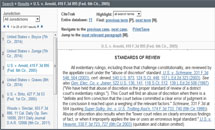Look at this query:
“income tax” w/10 fraud
In law school a Westlaw Rep taught you that the foregoing query returns any opinions where the phrase ‘income tax’ appears within 10 words of the word ‘fraud.’
This is a true statement. But it’s not the end of the inquiry. The query does something else. Something arbitrary.
What you are really doing with this query is asking the search engine to exclude any judicial opinions where the term ‘income tax’ appears within 11, 12 or 13 words of the term ‘fraud.’ You are saying: “Eleven words apart? I have no interest in such opinions. How could such a case possibly be relevant?”
Subscribers to WestlawNext and TheLaw.net who use the Within Connector are actually overriding the default algorithm. At TheLaw.net, our algorithm already considers proximity of search terms in relation to each other, and ranks them accordingly. So, that opinion you arbitrarily asked the search engine to exclude — that opinion with 11 words of separation — you’re going to see that opinion near the top of your results, by simply using the And Connector.
The correct query, therefore, is:
“income tax” and fraud
In the results, each opinion receives a percentage ranking in relation to the opinion that appears before and after it. The first opinion receives a ranking of 100% and the percentages digress in descending order from there. In addition to “proximity,” TheLaw.net’s algorithm also considers density, diversity and numerosity of search terms. Hence, this is not an algorithm you want to override. It is an algorithm you want to leverage. And, unlike WestlawNext which rents some databases for up to $4,000 an hour, TheLaw.net is still less than $50 a month for unlimited access to all 315 jurisdictions and much, much more.
SHOULD I EVER USE THE WITHIN CONNECTOR?
Yes. Use the Within Connector when you have a specific reason to override the default algorithm, thereby imposing your will on the search engine.
For example:
search w/2 seizure
In this example we know two things: (a) we know that search engines see the word ‘and’ as a connector, not as a word, per se. We also know that the term ‘search’ appears within two words of the term ‘seizure’. In other words, this is not an arbitrary query.
Here’s another example:
18 w/5 1344 and “false loan application”
In this search we know that the title number of the Federal bank fraud statute appears within five words of the section number. This query asks the search engine to return that subset of opinions that also includes at least one instance of the phrase “false loan application” anywhere in the opinion. By default, TheLaw.net ranks highest those opinions where ‘false loan application’ appears in close proximity to the item of information driving our search; in this example, that item of information is the Federal bank fraud statute.








